Practice Free MB-330 Exam Online Questions
DRAG DROP
A bottle manufacturing company uses Dynamics 365 Supply Chain Management to manage operations.
The company plans to install machines that accept empty bottles for a cash refund or donation at several recycling locations.
You need to complete the setup for installation of the assets.
What should you configure for each requirement? To answer, drag the appropriate features to the correct requirements. Each feature may be used once, more than once, or not at all. You may need to drag the split bar between panes or scroll to view content. NOTE; Each correct selection is worth one point.


DRAG DROP
A company manufactures wood furniture.
Customers can purchase cabinets on sales orders. Customer can select different wood finishes including oak and maple.
You need to configure a product attribute to characterize the types of cabinet finishes.
Which three actions should you perform in sequence? To answer, move the appropriate actions from the list of actions to the answer area and arrange them in the correct order.
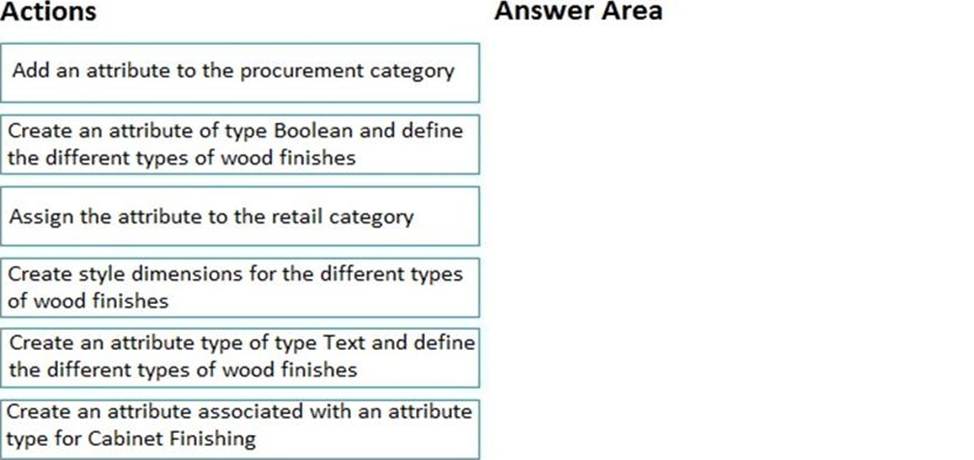
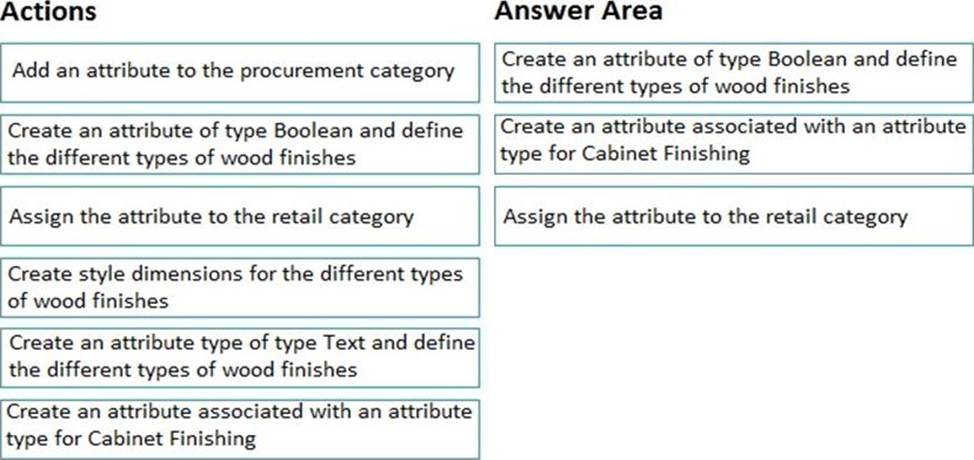
Explanation:
Reference: https://docs.microsoft.com/en-us/dynamics365/unified-operations/retail/attribute-attributegroups-lifecycle
A company uses Planning Optimization.
You need to ensure that the purchase price trade agreement lead time is used for an item.
What should you do?
- A . Set the days forward parameter.
- B . Set the Disregard lead time parameter to No.
- C . Set the Disregard lead time parameter to Yes.
- D . Override the item lead time parameter.
- E . Set the days backward parameter.
A company is implementing Dynamics 365 Supply Chain Management. The company manages
inventory by using a just-in-time
A purchase order arrives for an item. The system must allow sales order shipments of the item to posted before the purchase order invoice is received.
You must ensure that the item model group configuration allows for shipment of items.
Which parameter should you enable?
- A . Location profile negative inventory
- B . Financial negative inventory
- C . Physical inventory
- D . include physical value
- E . Registration requirements
B
Explanation:
Financial negative inventory:
If checked, the system will allow you to raise a Sales Order and directly Invoice while bypassing packing Slip only if the available physical quantity having status receipt as Received or Purchased. Means at least your available physical quantity should be physically posted.
If unchecked, system will not allow you to do the invoice even if all the items in the order are physically updated that means cost price should be known for the quantity that is financially pulled from inventory.
https://community.dynamics.com/ax/f/microsoft-dynamics-ax-forum/265813/physical-negative-inventory-and-financial-negative-inventory-on-item-model-group?pifragment-96834=1
DRAG DROP
A company is implementing Dynamics 365 Supply Chain Management for new warehouse management operations.
A three-tier workflow is being implemented for planned order approval. It is anticipated that a few days will need to be added to process the new planned orders.
During the yearly renegotiation of pricing, contractual lead times rather than the actual lead times are used, vendor score card analysis shows that certain vendors are often late in their shipments from their contractual lead time dates.
likely for the next three months while the new warehouse operations are adopted.
You need to configure safety margins to account for the new system processes.
Which safety margin should you use for each process? To answer, drag the appropriate safety margins to the correct processes. Each safety margin may be used once, more than once, or not at all. You may need to drag the split bar between panes or scroll to view content. NOTE Each correct selection is worth one point.


HOTSPOT
A distribution company implementing Dynamics 365 Supply Chain Management has two warehouses.
One item is purchased and stocked in only Warehouse1. Occasionally, Warehouse2 requires this item based on customer demand. When this occurs, an order for the item must be automatically created for Warehouse2.
You need to configure the automation of the order for Warehouse2.
What should you configure? To answer, select the appropriate options in the answer area. NOTE: Each correct selection is worth one point.
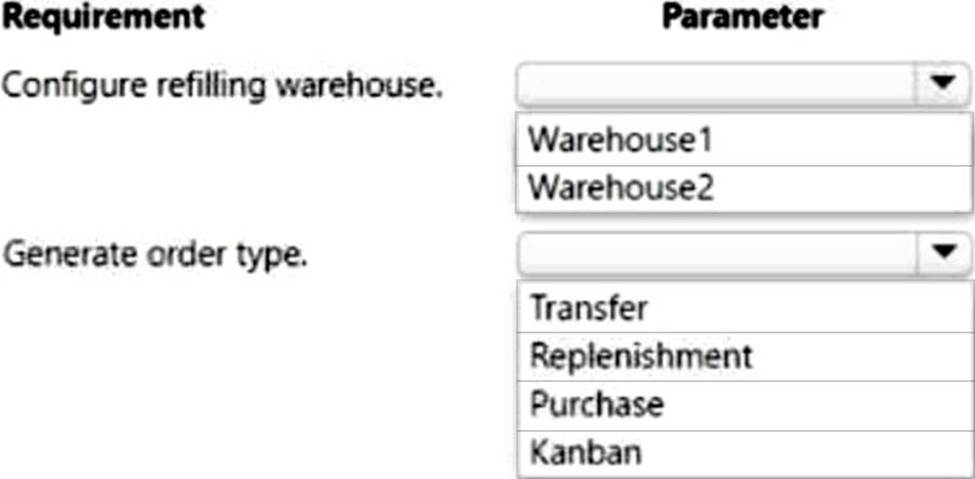
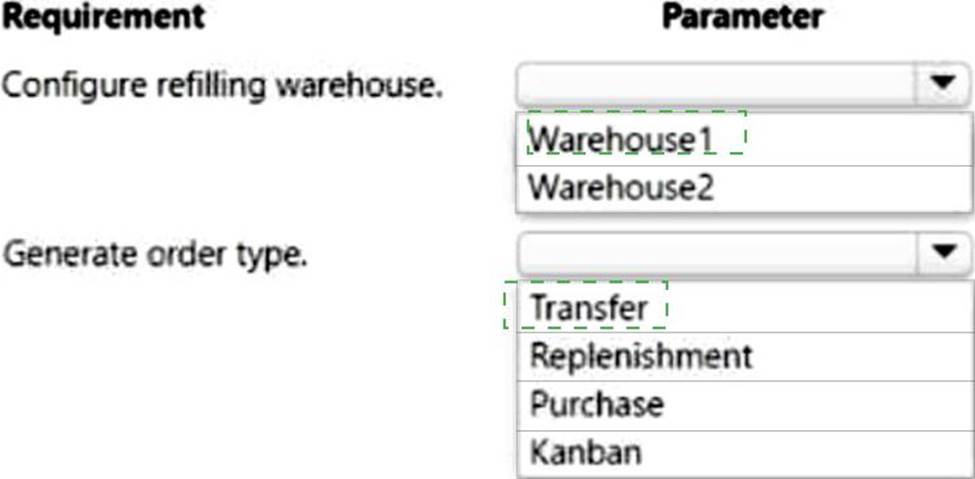
Explanation:
Box 1: Warehouse1
Set up warehouses for transfer orders.
You can use warehouse levels to create a hierarchy that supports transfer orders between warehouses. Based on this setup, master scheduling calculates item requirements at the individual warehouse level and generates planned transfer orders from an assigned source warehouse to fulfill them.
✑ Click Inventory management > Setup > Inventory breakdown > Warehouses.
✑ Select the warehouse that you want to refill.
✑ On the Master planning FastTab, select the Refilling check box.
✑ In the Main warehouse field, select the warehouse that you want to assign as the refilling warehouse. Master scheduling calculates a transfer requirement for the selected warehouse and generates a planned transfer order from the assigned Main warehouse.
Note: If you clear the Refilling check box, the selected warehouse is assigned a warehouse level in regard to the Main warehouse, but the Main warehouse is not set up as a refilling warehouse.
✑ Close the page to apply the new setup.
Box 2: Transfer
Reference: https://docs.microsoft.com/id-id/dynamics365/supply-chain/warehousing/transfer-orders-warehouse
DRAG DROP
You create and maintain items in Dynamics 365 Supply Chain Management.
You create a product master named SC001 for metal screws. Screws come in three different lengths and two styles. You want to release only five of the six possible combinations.
You need to set up variants for the screw.
Which three actions should you perform in sequence? To answer, move the appropriate actions from the list of actions to the answer area and arrange them in the correct order.
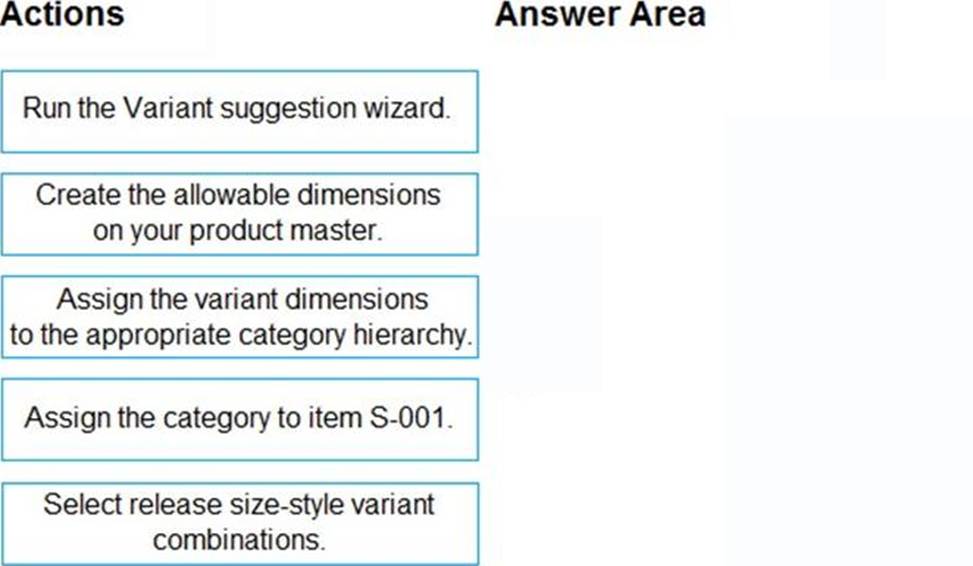
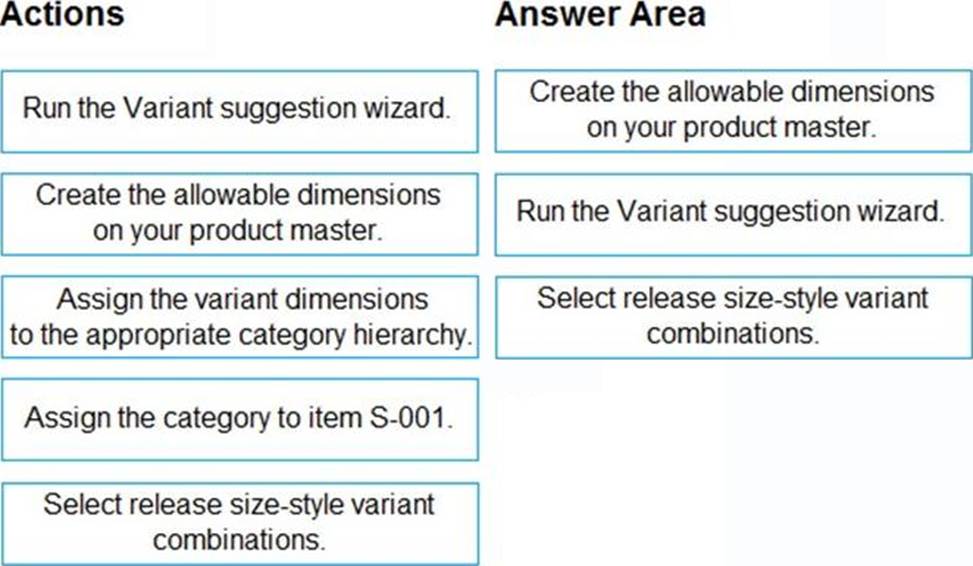
Explanation:
Reference: https://docs.microsoft.com/en-us/dynamics365/supply-chain/pim/tasks/create-predefined-product-variants
HOTSPOT
A company implementing Dynamics 365 Supply Chain Management has multiple warehouses, some of which are Warehouse Management-enabled.
The company must hold inventory for the following purposes:
✑ On-hand inventory available for all transactions except for sales orders.
✑ Automatic hold on inbound purchase order inventory.
✑ Damaged on-hand inventory that can be transferred from a mobile device, leaving the undamaged inventory available.
You need to determine the feature that applies to each company requirement.
Which features should you use? To answer, select the appropriate options in the answer area. NOTE: Each correct selection is worth one point.
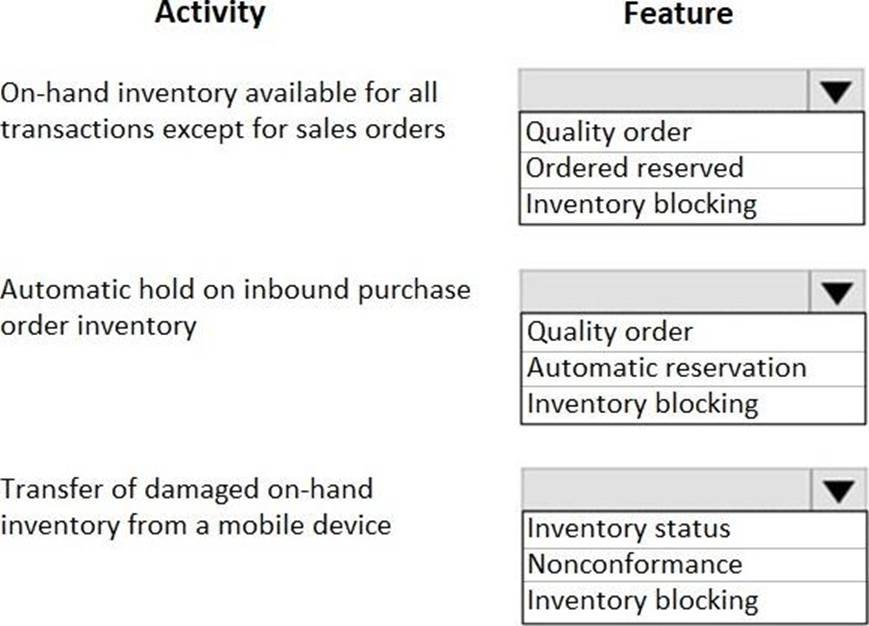
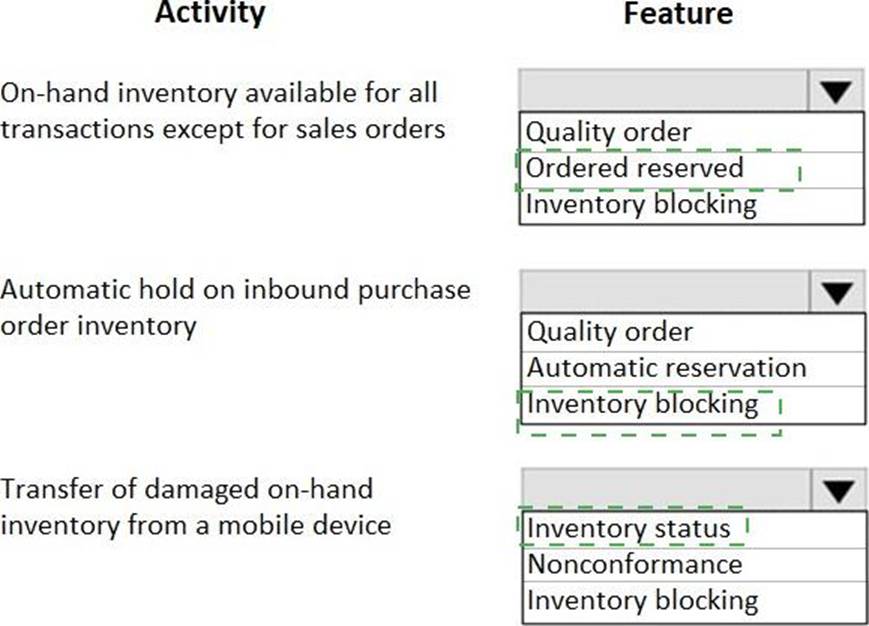
Explanation:
Box 1: Ordered reserved
On-hand inventory available for all transactions except for sales orders.
Query your on-hand inventory
To check the availability of inventory, go to Inventory management > Inquiries and reports > On-hand list.
The On-hand list page is automatically updated when transactions are made in inventory.
Those transactions might be forecasted, physical, or financial transactions.
For each matching item, the On-hand grid provides the following columns of inventory information.
* Ordered reserved – The total quantity that is reserved on ordered receipts. The value in this field represents the total quantity of items in outbound transactions that have a status of Ordered reserved. Items that are reserved as ordered aren’t physically available in inventory. Therefore, they can’t be directly picked and delivered.
* Etc.
Box 2: Inventory blocking
Automatic hold on inbound purchase order inventory.
Inventory blocking is part of the quality inspection process in Supply Chain Management.
You can use inventory blocking to prevent items from being processed or consumed.
You can block inventory items in the following ways:
Manually
By creating a quality order
By using a process that generates a quality order
By using inventory status blocking
Box 3: Inventory status
Damaged on-hand inventory that can be transferred from a mobile device, leaving the undamaged inventory available.
Set up and use inventory statuses
You can use inventory statuses to categorize inventory. You can then initiate appropriate actions, such as replenishment or put-away work.
Here are some examples of ways that you can use inventory statuses:
Create inventory statuses for on-hand inventory, inbound transactions, and outbound transactions.
Specify a default inventory status for warehouse transactions.
Change an inventory status for items before arrival, during arrival, or when the items are put away during inventory movement.
Use an inventory status to price items that are returned and to plan item coverage during master planning.
Incorrect:
* Quality Order
The Quality management for warehouse processes feature lets you integrate item sampling controls into the warehouse receiving process by using warehouse management processes (WMS). Warehouse work can be automatically generated to move inventory to the quality control location, based on a percentage or a fixed quantity, or based on every nth license plate. After a quality order has been completed, work can be automatically generated to move inventory to the next location in the process, depending on the quality results.
The Quality management for warehouse processes feature extends the capabilities of the basic quality management feature. It provides the option to create quality orders for the inventory that is sent to the quality control location, although quality orders aren’t always required. Therefore, it allows for a lightweight quality control process that is based on warehouse work.
* Nonconformance
A nonconformance describes an item that has a quality problem. The nonconformance process lets you create a nonconformance order that describes a quantity of nonconforming material, the problem source, the problem type, and explanatory notes.
Reference:
https://learn.microsoft.com/en-us/dynamics365/supply-chain/inventory/inventory-on-hand-list
https://learn.microsoft.com/en-us/dynamics365/supply-chain/inventory/quality-management-for-warehouses-processes
https://learn.microsoft.com/en-us/dynamics365/supply-chain/inventory/inventory-blocking
You need to complete the shipments.
- A . Confirm the load and generate packing slips and bills of lading.
- B . Create waves to generate work for shipping loads and send an ASN.
- C . Confirm shipments and generate pick/put work.
- D . Create work for printing shipping documents and send an ASN.
B
Explanation:
Reference: https://docs.microsoft.com/en-us/dynamics365/supply-chain/warehousing/wave-processing
You use Dynamics 365 Supply Chain Management to manage inventory.
You need to adjust inventory and override the current item posting setup.
Which journal type should you use?
- A . inventory adjustment
- B . inventory transfer
- C . movement
- D . item arrival
C
Explanation:
Reference: https://docs.microsoft.com/en-us/dynamics365/supply-chain/inventory/inventory-journals
